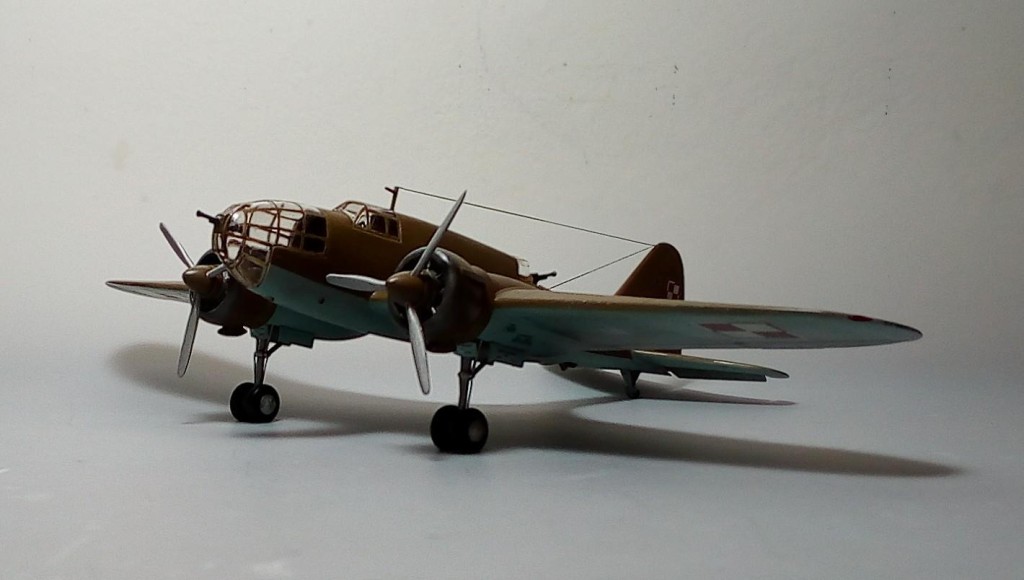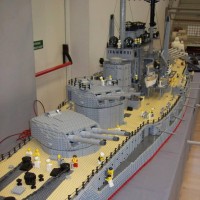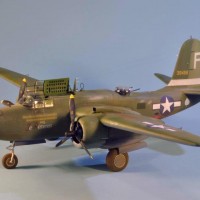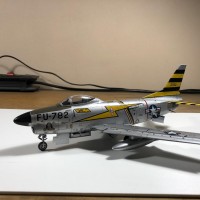Mirage 1/72 PZL.37A
Whereas in 1928 the Polish Department of Aeronautics ordered aviation manufacturer Państwowe Zakłady Lotnicze (PZL) to make preparations towards the development of a multi-engine night bomber, it was finally decided to procure a number of Fokker F.VIIs to meet the bomber role.
It was not until October 1934 that PZL at long last was granted a “GO” to proceed with its multi-engine bomber project.
In response to the feedback from flight testing, the second prototype, known as PZL.37/II, featured, among others, twin-vertical stabilizers, a reworked cockpit and an altered ventral gun position: it was this type that was accepted for production.
The first 10 serial aircraft, designated as the PZL.37A, were furnished with the initial design's single vertical stabilizer, with the next 19 interim aircraft, constructed to the PZL.37A "bis" standard, outfitted with twin tail configuration. All of these "A" series aircraft were powered by licensed built Bristol Pegasus (PZL Pegaz) XII B radial engines. The PZL.37B (or: Łoś II), the main production variant that followed, was furnished with the twin tail arrangement along with newer Pegaz XX engines.
Prior to the war, the type was widely considered to be one of the most advanced bombers then operational in the world. The conventional in layout bomber was able to carry a heavier bomb load than considerably larger aircraft, though the dimensions of the individual bombs were limited. Being smaller than most contemporary medium bombers, it was relatively fast and easy to handle.
During early 1938, the Polish Air Force operational Units started to receive the Łos A variant, followed by deliveries of the improved Łos B, which had been slowed by delays in supply of the Pegaz XX engines and other equipment. With only a few months available to train the crews and complete the equipping of the bombers, the planes were not fully ready when the war broke out.
By the outbreak of the war, an estimated 92 machines had been produced and delivered to the Polish Air Force, with a further 31 being in different phases of construction. Upon the invasion, a number of P.37s had been deployed to rural improvised airfields, so they were not destroyed on the ground by the Germans in their initial attack on the main Polish air bases. However, because of this move-away from developed airfields to short fields with poor surfaces, the planes could take off with only a fraction of their maximum bomb load which limited their effectiveness.
From 4 September onward the planes of the Bomber Brigade were attacking German armored columns in day attacks, forced by the desperate situation to perform missions for which they were not designed for. During these engagements, the type suffered heavy losses as a result of a lack of adequate fighter protection, further amplified by the operational tactics employed, usually flying missions in units of no more than three aircraft at a time.
There are no surviving PZL.37 aircraft, only an original Pegaz XX engine, exhibited at Muzeum Lotnictwa Polskiego w Krakowie. A full scale mock-up has been assembled by PZL Mielec and is currently exhibited outdoors on the grounds of the factory.
The P.37 is a sounding paradigm of Polish Aviation industrial capability to come up with formidable machines. Though having its vices (like unforgiving stall behavior, or reduced takeoff weight from rough airfields - but, frankly, which aircraft of the era did not have any?), the type was otherwise pleasant to fly, rugged and easy to maintain: a successful design that war conditions did not allow to show its full potential.
The Mirage Hobby is a reboxed ZTS Plastyk mold, by all means an old, classic kit that can still produce a decent representation the important bomber. It was a gift from my friend @lis, that I became instantly motivated to build it upon receiving it. Thank you @lis! Thanks All who followed my build thread!
Should you wish to read the full review, you might do so by visiting my beloved site Modelingmadness:
https://modelingmadness.com/review/allies/pol/penz37.htm
Happy modelling!




















Well done, Spiros. Your small added details add the "right stuff".
Thanks my friend @gwskat!
Great build and ditto article, Spiros @fiveten
Those small additions do indeed add a lot to the looks of this aircraft.
Well done.
Thanks my friend @johnb!
Love the unusual subjects, and you strike yet again with another! Looks great.
Thanks my friend @gkittinger!
Impresive build @fiveten ! And great article! It was pleasure to follow Your thread!
Thanks for everything, my friend @lis!
Very nice @fiveten these canopies are so hard to get right but you did a great job on this polish bomber!
Thanks my friend @michel-verschuere!
Nice job on a plane that is not often modeled, Spiros (@fiveten). The Polish Air Force had some interesting planes at the start of the war. Nice job dropping the elevators and adding the small details.
Thanks my friend @gblair!
Very nice Spiros! (@fiveten) Extra details really paid off- great job as well on all that glass up front! Thanks for sharing
Thanks my friend @dbutlr
Looks like Lis (@lis) sent that to to the right guy!
Great work on this kit Spiros, and a great right up also for the MM posting.
Thanks my friend @georgeswork!
Nice to see something not modeled often, looks great! @fiveten.
Thanks my friend @roofrat!
Nice build and great result of a good looking plane Spiros!
Thanks my friend Rory!
Great write-up, Spiros, and an equally great build of this often neglected aircraft.
Thanks my friend @chinesegeorge!
Nicely done Spiros.
Thanks my friend @kalamazoo!
Cool build, Spiros! I love that you like to do the one offs and oddballs and this one definitely fits the bill. Well done!
Thanks my friend @jetmex!
Nice job Spiros @fiveten! I had to look twice to see it was older kit of this aircraft. You made this build look great, I love it!
Thanks my friend @v1pro!